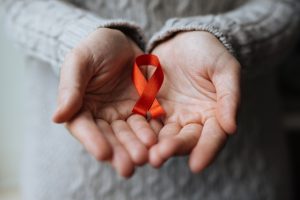December 1st – World AIDS Day: Know Your Status
November 30, 2018
 The theme for World AIDS Day this year is “Know Your Status.” According to the World Health Organization, there are almost 37 million people across the world with HIV. One in four people with HIV infection don’t know they have it. HIV, human immunodeficiency virus, is the virus that causes AIDS, acquired immunodeficiency syndrome. Sepsis is the major cause of death for people who have AIDS.
The theme for World AIDS Day this year is “Know Your Status.” According to the World Health Organization, there are almost 37 million people across the world with HIV. One in four people with HIV infection don’t know they have it. HIV, human immunodeficiency virus, is the virus that causes AIDS, acquired immunodeficiency syndrome. Sepsis is the major cause of death for people who have AIDS.
The risk of not knowing HIV status not only affects the person who is infected, but those around them. People who are HIV-positive but aren’t aware can unknowingly infect others. The virus can’t be spread through casual and every day contact, such as shaking hands, hugging, and kissing, but it can be transmitted to other people through the exchange of body fluids, such as blood, semen, and vaginal secretions.
HIV affects your body’s immune system, reducing your ability to fight infections. There is no cure for HIV but there are medications called antiretroviral therapy that can help control the virus. This therapy helps keep the HIV from overwhelming your immune system and causing AIDS. Effective treatment with antiretroviral therapy before the virus has progressed can help people with HIV lead a long and healthy life, almost as long as for people who don’t have HIV.
Common infections among people with HIV
Because HIV lowers your body’s ability to fight infection, any bacteria, virus, fungus, or parasite can be serious, and can trigger sepsis. People with HIV who develop sepsis are more difficult to treat and are more likely to die.
Some types of infections are not usually seen in people who are HIV-negative but are more often diagnosed among people with HIV. These are called opportunistic infections because they take advantage of the weakened immune system. Some of the more common life-threatening infections include Pneumocystis pneumonia (PCP), cytomegalovirus (CMV), toxoplasmosis, and Mycobacterium avium complex (MAC). People with HIV may also be infected with more common diseases such as hepatitis and tuberculosis.
Infection prevention for people with HIV
Aside from the standard infection prevention tips, such as proper hand washing and being up-to-date with vaccinations, people with HIV must be more cautious in the following situations:
- Preparing food: Infections caused by contaminated food may make someone without HIV sick for a few days. However, for people who are HIV-positive, bacteria, fungi, or parasites on food can be very serious, even fatal. Avoid drinking untreated water, like from lakes or streams. Don’t consume unpasteurized dairy products, raw or undercooked eggs, or fruit and vegetables that have not been cleaned well.
- Caring for animals: Some infections can be spread from animal to human, so wear gloves when cleaning up after your pet and cleaning litter boxes. Ensure your pets are up-to-date on their own vaccinations.
- Using personal products: Don’t share personal products, such as razors, nail clippers, and other items that could expose you to blood.
- Get tested regularly: Regular blood tests monitor your CD4 cell levels. CD4 cells are a type of white blood cell that helps fight infection. If your CD4 levels start to dip, your doctor may recommend antiretroviral therapy.
No one is immune from contracting HIV, but some groups of people are at higher risk. Visit the HIV Transmission page at the Centers for Disease Control and Prevention (CDC) to learn more about HIV risk, prevention, and who should get tested.
If you believe you may be at risk for contracting HIV, seek medical help as soon as possible. When HIV and AIDS were first discovered several decades ago, the outlook was dismal. But while HIV is still a serious virus, with proper treatment and support, it is no longer the death sentence it once was. Knowing your HIV status can help prevent further spread while helping you live longer.
To learn more about the connection between HIV and sepsis, visit Sepsis and HIV/AIDS. To read about infection prevention, visit Sepsis and Prevention.





























